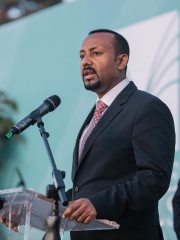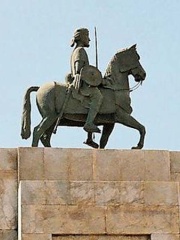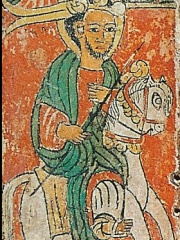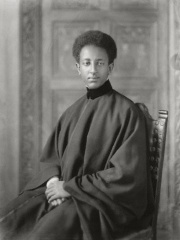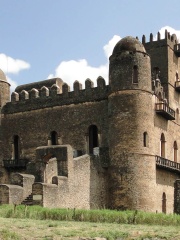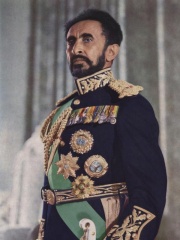
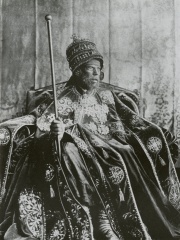
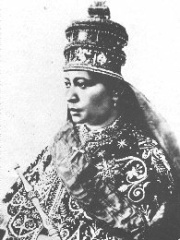
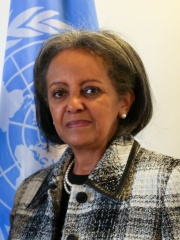
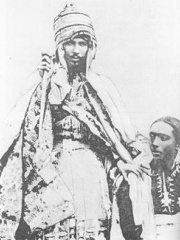
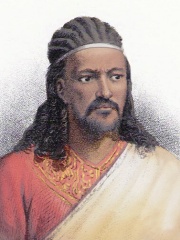
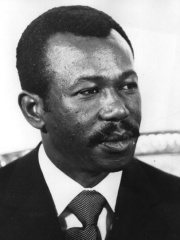
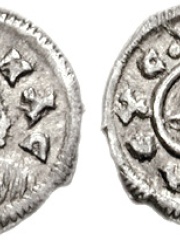
The Most Famous
POLITICIANS from Ethiopia
This page contains a list of the greatest Ethiopian Politicians. The pantheon dataset contains 19,576 Politicians, 33 of which were born in Ethiopia. This makes Ethiopia the birth place of the 84th most number of Politicians behind Moldova, and Slovenia.
Top 10
The following people are considered by Pantheon to be the top 10 most legendary Ethiopian Politicians of all time. This list of famous Ethiopian Politicians is sorted by HPI (Historical Popularity Index), a metric that aggregates information on a biography's online popularity. Visit the rankings page to view the entire list of Ethiopian Politicians.

1. Haile Selassie (1892 - 1975)
With an HPI of 86.85, Haile Selassie is the most famous Ethiopian Politician. His biography has been translated into 102 different languages on wikipedia.
Haile Selassie I (born Tafari Makonnen or Lij Tafari; 23 July 1892 – 27 August 1975) was Emperor of Ethiopia from 1930 to 1974. He rose to power as the Regent Plenipotentiary of Ethiopia (Enderase) under Empress Zewditu between 1916 and 1930. Widely considered to be a defining figure in modern Ethiopian history, he is accorded divine importance in Rastafari, an Abrahamic religion that emerged in the 1930s. A few years before he began his reign over the Ethiopian Empire, Selassie defeated Ethiopian army commander Ras Gugsa Welle Bitul, nephew of Empress Taytu Betul, at the Battle of Anchem. He belonged to the Solomonic dynasty, founded by Emperor Yekuno Amlak in 1270. Selassie, seeking to modernise Ethiopia, introduced political and social reforms including the 1931 constitution and the abolition of slavery in 1942. He led the empire during the Second Italo-Ethiopian War, and after its defeat was exiled to the United Kingdom. When the Italian occupation of East Africa began, he traveled to Anglo-Egyptian Sudan to coordinate the Ethiopian struggle against Fascist Italy; he returned home after the East African campaign of World War II. He dissolved the Federation of Ethiopia and Eritrea, established by the United Nations General Assembly in 1950, and annexed Eritrea as one of Ethiopia's provinces, while also fighting to prevent Eritrean secession. As an internationalist, Selassie led Ethiopia's accession to the United Nations. In 1963, he presided over the formation of the Organisation of African Unity, the precursor of the African Union, and served as its first chairman. By the early 1960s, prominent African socialists such as Kwame Nkrumah envisioned the creation of a "United States of Africa". Their rhetoric was anti-Western; Selassie saw this as a threat to his alliances. He attempted to influence a more moderate posture within the group. Amidst popular uprisings, Selassie was overthrown by the Derg military junta in the 1974 coup d'état. With support from the Soviet Union, the Derg began governing Ethiopia as a Marxist–Leninist state. In 1994, three years after the fall of the Derg regime, it was revealed to the public that the Derg had assassinated Selassie at the Jubilee Palace in Addis Ababa on 27 August 1975. On 5 November 2000, his excavated remains were buried at the Holy Trinity Cathedral of Addis Ababa. Among adherents of Rastafari, Selassie is called the returned Jesus, although he was an adherent of the Ethiopian Orthodox Church himself. He has been criticised for his suppression of rebellions among the landed aristocracy (Mesafint), which consistently opposed his changes. Others have criticised Ethiopia's failure to modernise rapidly enough. During his reign, the Harari people were persecuted and many left their homes. His administration was criticised as autocratic and illiberal by groups such as Human Rights Watch. According to some sources, late into Selassie's administration, the Oromo language was banned from education, public speaking and use in administration, though there was never a law that criminalised any language. His government relocated many Amhara people into southern Ethiopia.

2. Menelik II (1844 - 1913)
With an HPI of 77.49, Menelik II is the 2nd most famous Ethiopian Politician. His biography has been translated into 50 different languages.
Menelik II (Ge'ez: ዳግማዊ ምኒልክ dagmawi mənilək; horse name Aba Dagnew (Amharic: አባ ዳኘው abba daññäw); 17 August 1844 – 12 December 1913), baptised as Sahle Maryam (ሣህለ ማርያም sahlä maryam), was king of Shewa from 1866 to 1889 and Emperor of Ethiopia from 1889 to his death in 1913. A member of the Solomonic dynasty, Menelik expanded the Ethiopian Empire to its greatest historical extent and defeated Italian colonial forces at the Battle of Adwa in 1896. He is widely regarded as the founder of the modern Ethiopian state. A member of the Shewan branch of the Solomonic dynasty, Menelik was born in Angolalla, Shewa, as Sahle Maryam, the son of Haile Melekot (Negus of Shewa). Named "Menelik" by his grandfather King Sahle Selassie after the legendary Menelik I (son of Solomon and the Queen of Sheba), he was imprisoned at age 11 by Emperor Tewodros II at the fortress of Magdala following his father's death in 1855. He escaped in 1865 amid Tewodros's declining power, returned to Shewa, and was acclaimed as its rightful king. Though harboring imperial ambitions, he avoided challenging northern rivals during the British Expedition to Abyssinia in 1868 and submitted to Emperor Yohannes IV in 1878 after failed collaboration with the Egyptians during their invasion (1875–1876). As quasi-independent ruler of Shewa from 1878 to 1889, Menelik built his power base through direct European diplomacy, securing modern weapons and expertise from advisors like Swiss engineer Alfred Ilg. He conquered southern territories inhabited by Oromo, Wolayta, and Kaffa peoples, exploiting ivory, coffee, gold, and slave trade revenues to fund arms, while establishing fortified katama settlements and the neftenya land system. The strategic conquest of Harar in 1887 made it Shewa's trade hub under Ras Makonnen. Following Yohannes's death at the Battle of Metemma in 1889, Menelik was crowned emperor at Mount Entoto on 3 November 1889. Menelik signed the Treaty of Wuchale with Italy in 1889; the Italian version implied a protectorate, while the Amharic allowed optional use of Italian diplomacy—a deliberate deceit he repudiated by 1891. The treaty also stated in both languages that Ethiopia was to cede Mereb Melash and with it all access to the Red Sea. Mobilising a unified army of over 100,000, he crushed Italian forces at the Battle of Adwa on 1 March 1896, securing Ethiopia's independence and full European recognition. He defined borders through treaties with Britain, France, and Italy, initiated the Addis Ababa–Djibouti Railway, and centralized governance with ministries, schools, and a state bank. After strokes from 1906 left him incapacitated by 1909, Empress Taytu Betul and later Ras Tessema Nadew served as regents. He died in 1913 and was succeeded by grandson Lij Iyasu (later deposed), followed by daughter Zewditu and Ras Tafari Makonnen (the future Haile Selassie). Menelik was a controversial figure for much of his reign. Although praised internationally as a symbol of African resistance to colonialism and credited with being the architect of modern Ethiopia, critics among incorporated ethnic groups accused him of forced assimilation, land expropriation, and cultural suppression that contributed to later ethnic tensions.

3. Zewditu (1876 - 1930)
With an HPI of 76.79, Zewditu is the 3rd most famous Ethiopian Politician. Her biography has been translated into 46 different languages.
Zewditu (Ge'ez: ዘውዲቱ, born Askala Maryam; 29 April 1876 – 2 April 1930) was Empress of Ethiopia from 1916 until her death in 1930. She officially adopted the regnal name "Zewditu" at the beginning of her reign, which was triggered by the dethroning of Lij Iyasu in 1916. Her coronation was held on February 11, 1917, in the Cathedral of St. George in Addis Ababa—a capital founded by her father. Forty years old and childless when crowned, she is the first and only empress regnant of the Ethiopian Empire. Described as the first modern female head of a nation in Africa, she was the last female Ethiopian head of state until the 2018 election of Sahle-Work Zewde as president. Her reign, which she is said to have closely patterned after the legacy of Queen Victoria of the United Kingdom, is noted for the reforms of her Regent and heir apparent Ras Tafari Makonnen (who succeeded her as Emperor Haile Selassie I) – changes which she was at best ambivalent and often stridently opposed to, due to her staunch conservatism and strong religiosity. Empress Zewditu sought to maintain Ethiopia's traditional values during her reign through a series of conservative policies, resisting rapid modernization. Ascending to the throne in 1916 after the deposition of Emperor Iyasu V, she was supported by conservative factions and the Ethiopian Orthodox Church, who saw her as a stabilizing figure. Faced with significant internal challenges, she navigated power struggles between conservative and modernist factions within the country. Despite her conservative stance, Zewditu had to deal with the complexities of a nation under pressure to modernize and engage with foreign powers. During her reign, Ethiopia experienced political manoeuvring, with Ras Tafari pushing for reforms and international diplomacy, creating a dual power dynamic that defined her rule. Ethiopia's attempts to assert its sovereignty amidst external threats, particularly from colonial powers like Italy, marked this period. Her commitment to preserving Ethiopian independence and cultural heritage was a notable aspect of her leadership. However, resistance to rapid modernization and reliance on traditionalist policies led to tensions within the government and society. The death of Empress Zewditu in 1930, under circumstances still somewhat unclear, marked the end of an era and paved the way for Ras Tafari to succeed her as Emperor Haile Selassie I. Her legacy reflects efforts to maintain traditional values while facing the inevitability of change, and her personal her dedication to the Ethiopian Orthodox faith and her role in a transitional period that set the stage for the modernization efforts that followed. Critics argue that her conservative policies may have hindered Ethiopia's progress and adaptation to the modern world. However, supporters highlight her significant role in maintaining Ethiopian sovereignty and cultural identity during a period of potential upheaval. Her reign remains a topic of study for its insights into the challenges of leadership during a time of significant political and social change.

4. Sahle-Work Zewde (b. 1950)
With an HPI of 74.61, Sahle-Work Zewde is the 4th most famous Ethiopian Politician. Her biography has been translated into 71 different languages.
Sahle-Work Zewde (Amharic: ሣህለ ወርቅ ዘውዴ; born 21 February 1950) is an Ethiopian diplomat who served as president of Ethiopia from 2018 to 2024, the first woman to hold the office. She was elected as president unanimously by members of the Federal Parliamentary Assembly on 25 October 2018. American business magazine Forbes, on its annual edition of the Forbes list of The World's 100 Most Powerful Women, listed Sahle-Work as the 93rd most powerful woman in the world, making her the highest-ranking African woman on the list.
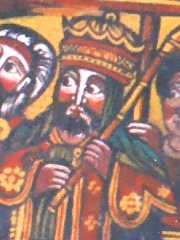
5. Menelik I (954 BC - 930 BC)
With an HPI of 72.93, Menelik I is the 5th most famous Ethiopian Politician. His biography has been translated into 31 different languages.
Menelik I (Ge'ez: ምኒልክ, Mənilək) was the legendary first Emperor of Ethiopia's Solomonic dynasty. According to Kebra Nagast, a 14th-century national epic, in the 10th century BC he is said to have inaugurated the Solomonic dynasty of Ethiopia, so named because Menelik I was the son of the biblical King Solomon of ancient Israel and of Makeda, the Queen of Sheba.

6. Yohannes IV (1837 - 1889)
With an HPI of 72.37, Yohannes IV is the 6th most famous Ethiopian Politician. His biography has been translated into 32 different languages.
Yohannes IV (Tigrinya: ዮሓንስ ፬ይ Rabaiy Yōḥānnes; horse name Abba Bezbiz also known as Kahśsai; born Lij Kahssai Mercha; 11 July 1837 – 10 March 1889) was Emperor of Ethiopia from 1871 to his death in 1889 at the Battle of Gallabat, and king of Tigray from 1869 to 1871. During his reign he successfully defended Ethiopia against a large-scale Egyptian invasion. In his earlier years, he rebelled against Tewodros II; having risen to power in the 1860s, he maintained the policy of Tewodros, that of continued unification and also implemented a policy of touring entire regions and meetings with governors. He assisted the British in their British expedition to Abyssinia which ended in Tewodros' suicide, from which Yohannes was rewarded in ammunition and artillery. He regarded Islam as a hindrance to the stability of the state and worked to strengthen Christian dominance in Ethiopia. Its estimated that he had converted 550,000 Oromos and Jebertis to Christianity. In foreign policy, he had disagreements and military conflicts with both Isma'il Pasha of the Khedivate of Egypt and Muhammad Ahmad during the latter's Mahdist War.

7. Tewodros II (1818 - 1868)
With an HPI of 72.00, Tewodros II is the 7th most famous Ethiopian Politician. His biography has been translated into 37 different languages.
Tewodros II (Ge'ez: ዳግማዊ ቴዎድሮስ, once referred to by the English cognate Theodore; baptized as Kassa, c. 1818 – 13 April 1869) was Emperor of Ethiopia from 1855 until his death in 1869. His rule is often placed as the beginning of modern Ethiopia and brought an end to the decentralized Zemene Mesafint (Era of the Princes). Although Tewodros II's origins were in the Era of the Princes, his ambitions were not those of the regional nobility. He sought to re-establish a cohesive Ethiopian state and to reform its administration and church. Tewodros II's first task after having reunited the other provinces was to bring Shewa under his control. During the Era of the Princes, Shewa was, even more than most provinces, an independent entity, its ruler even styling himself Negus, the title for King. In the course of subduing the Shewans, Tewodros took with him a Shewan prince, Sahle Maryam, who he brought up as his own son, who would later become Emperor (or Atse) himself as Menelik II. Despite his success against Shewa, Tewodros faced constant rebellions by nobles in other regions resisting modernization. He ultimately committed suicide at the Battle of Magdala, during the British Expedition to Abyssinia. In the first six years of his reign, the new ruler managed to put down these rebellions, and the empire was relatively peaceful from about 1861 to 1863, but the energy, wealth, and manpower necessary to deal with regional opposition limited the scope of Tewodros's other activities. Tewodros II never realized his dream of restoring a strong monarchy, although he took many important initial steps. He sought to establish the principle that governors and judges must be salaried appointees. He also established a professional standing army, rather than depending on local lords to provide soldiers for his expeditions. He introduced the collection of books in the form of a library, tax codes, as well as a centralized political system with respective administrative districts. He also intended to reform the church but he was confronted by strong opposition when he tried to impose a tax on church lands to help finance government activities. Tewodros confiscation of these lands gained him enemies in the church and little support elsewhere. Essentially, Tewodros was a talented military campaigner.

8. Mengistu Haile Mariam (b. 1937)
With an HPI of 71.78, Mengistu Haile Mariam is the 8th most famous Ethiopian Politician. His biography has been translated into 65 different languages.
Mengistu Haile Mariam (Amharic: መንግሥቱ ኀይለ ማርያም, pronunciation: [mənɡɨstu haɪlə marjam]; born 21 May 1937) is an Ethiopian former politician, revolutionary, and military officer who served as the head of state of Ethiopia from 1977 to 1991. He was General Secretary of the Workers' Party of Ethiopia from 1984 to 1991, chairman of the Derg—the Marxist–Leninist military junta that ruled Ethiopia—from 1977 to 1987, and president of the People's Democratic Republic of Ethiopia (PDRE) from 1987 to 1991. The Derg seized power in the Ethiopian Revolution following the overthrow of Emperor Haile Selassie in 1974, marking the end of the Solomonic dynasty which had ruled Ethiopia since the 13th century. Mengistu purged his rivals within the Derg and made himself dictator of Ethiopia, attempting to modernize the feudal economy of Ethiopia through Marxist–Leninist-inspired policies such as nationalization and land redistribution. His bloody consolidation of power in 1977–1978 is known as the Ethiopian Red Terror—a brutal crackdown on opposition groups and civilians following a failed assassination attempt by the Ethiopian People's Revolutionary Party (EPRP) in September 1976, after it had ignored the Derg's invitation to join the union of socialist parties. The death toll is unknown but is estimated at between 30,000 and 750,000 by the Ethiopian Red Terror Documentation and Research Center. Internal rebellion, government repression, and economic mismanagement characterized Mengistu's presidency, the Red Terror period being a battle for dominance between the Derg, the EPRP, and their rival the All-Ethiopia Socialist Movement (MEISON), which had initially aligned itself with the Derg. While this internal conflict was being fought, Ethiopia was threatened by both the Somali invasion and the guerrilla campaign of the Eritrean People's Liberation Front, who demanded independence for Eritrea, then a province of Ethiopia. The Ogaden War of 1977–1978 with Somalia, fought over a disputed border region (Ogaden), was notable for the prominent role of Mengistu's Soviet and Cuban allies in securing an Ethiopian victory. The catastrophic famine of 1983–1985 is what brought his government the most international attention. Mengistu fled to Zimbabwe in May 1991 after the PDRE National Shengo dissolved itself and called for a transitional government. His departure brought an abrupt end to the Ethiopian Civil War. Mengistu Haile Mariam still lives in Harare, Zimbabwe, despite an Ethiopian court verdict which found him guilty of genocide in absentia. Mengistu's government is estimated to be responsible for the deaths of 500,000 to 2,000,000 Ethiopians, mostly during the 1983–1985 famine in Ethiopia.

9. Ezana of Axum (325 - 360)
With an HPI of 71.76, Ezana of Axum is the 9th most famous Ethiopian Politician. His biography has been translated into 36 different languages.
Ezana (Ge'ez: ዔዛና, ‘Ezana, unvocalized ዐዘነ ‘zn), (Ancient Greek: Ἠεζάνα, Aezana) was the ruler of the Kingdom of Aksum (320s – c. 360 AD). One of the best-documented rulers of Aksum, Ezana is important as he first adopted for his country the religion of Christianity and the name of Ethiopia. Tradition states that Ezana succeeded his father Ella Amida (Ousanas) as king while still a child; his mother, Sofya, served as regent until he came of age.
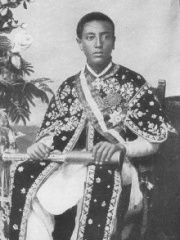
10. Lij Iyasu of Ethiopia (1895 - 1935)
With an HPI of 71.27, Lij Iyasu of Ethiopia is the 10th most famous Ethiopian Politician. His biography has been translated into 27 different languages.
Lij Iyasu (Ge'ez: ልጅ ኢያሱ; 4 February 1895 – 25 November 1935) also known as Iyasu V was the designated Emperor of Ethiopia from 1913 to 1916. His baptismal name was Kifle Yaqob (ክፍለ ያዕቆብ kəflä y’aqob). Ethiopian emperors traditionally chose their regnal name on the day they were crowned, and since he was never crowned, he is usually referred to as Lij Iyasu, "Lij" meaning child, especially one born of royal blood.
People
Pantheon has 33 people classified as Ethiopian politicians born between 954 BC and 1981. Of these 33, 9 (27.27%) of them are still alive today. The most famous living Ethiopian politicians include Sahle-Work Zewde, Mengistu Haile Mariam, and Abiy Ahmed. The most famous deceased Ethiopian politicians include Haile Selassie, Menelik II, and Zewditu. As of April 2024, 1 new Ethiopian politicians have been added to Pantheon including Pnina Tamano-Shata.
Living Ethiopian Politicians
Go to all RankingsSahle-Work Zewde
1950 - Present
HPI: 74.61
Mengistu Haile Mariam
1937 - Present
HPI: 71.78
Abiy Ahmed
1976 - Present
HPI: 70.15
Ismaïl Omar Guelleh
1946 - Present
HPI: 68.60
Hailemariam Desalegn
1965 - Present
HPI: 65.42
Abdiqasim Salad
1941 - Present
HPI: 64.58
Mulatu Teshome
1955 - Present
HPI: 62.52
Zera Yacob Amha Selassie
1953 - Present
HPI: 60.13
Pnina Tamano-Shata
1981 - Present
HPI: 43.46
Deceased Ethiopian Politicians
Go to all RankingsHaile Selassie
1892 - 1975
HPI: 86.85
Menelik II
1844 - 1913
HPI: 77.49
Zewditu
1876 - 1930
HPI: 76.79
Menelik I
954 BC - 930 BC
HPI: 72.93
Yohannes IV
1837 - 1889
HPI: 72.37
Tewodros II
1818 - 1868
HPI: 72.00
Ezana of Axum
325 - 360
HPI: 71.76
Lij Iyasu of Ethiopia
1895 - 1935
HPI: 71.27
Ahmad ibn Ibrahim al-Ghazi
1506 - 1543
HPI: 70.30
Gebre Mesqel Lalibela
1200 - 1221
HPI: 69.20
Amha Selassie
1916 - 1997
HPI: 68.02
Fasilides
1603 - 1667
HPI: 67.04
Newly Added Ethiopian Politicians (2025)
Go to all RankingsOverlapping Lives
Which Politicians were alive at the same time? This visualization shows the lifespans of the 15 most globally memorable Politicians since 1700.

